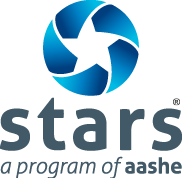| Overall Rating | Silver - expired |
|---|---|
| Overall Score | 50.83 |
| Liaison | Hannah Spirrison |
| Submission Date | March 29, 2018 |
| Executive Letter | Download |
Antioch College
OP-5: Building Energy Consumption
| Status | Score | Responsible Party |
|---|---|---|

|
3.36 / 6.00 |
Jackie
Ashworth Director, Physical Plant Physical Plant |
Figures needed to determine total building energy consumption:
| Performance Year | Baseline Year | |
| Grid-purchased electricity | 13,721 MMBtu | 13,772 MMBtu |
| Electricity from on-site renewables | 191 MMBtu | 194 MMBtu |
| District steam/hot water (sourced from offsite) | 0 MMBtu | 0 MMBtu |
| Energy from all other sources (e.g., natural gas, fuel oil, propane/LPG, district chilled water, coal/coke, biomass) | 11,677 MMBtu | 14,433 MMBtu |
| Total | 25,589 MMBtu | 28,399 MMBtu |
Start and end dates of the performance year and baseline year (or 3-year periods):
| Start Date | End Date | |
| Performance Year | Jan. 1, 2017 | Dec. 31, 2017 |
| Baseline Year | Jan. 1, 2014 | Dec. 31, 2016 |
A brief description of when and why the building energy consumption baseline was adopted (e.g. in sustainability plans and policies or in the context of other reporting obligations):
The 3-year period from January 1, 2014 to December 31, 2016 is used as the energy consumption baseline for consistency across all sustainability reporting.
Gross floor area of building space:
| Performance Year | Baseline Year | |
| Gross floor area of building space | 388,246 Gross square feet | 371,761 Gross square feet |
Source-site ratio for grid-purchased electricity:
Total building energy consumption per unit of floor area:
| Performance Year | Baseline Year | |
| Site energy | 0.07 MMBtu per square foot | 0.08 MMBtu per square foot |
| Source energy | 0.14 MMBtu per square foot | 0.16 MMBtu per square foot |
Percentage reduction in total building energy consumption (source energy) per unit of floor area from baseline:
Degree days, performance year (base 65 °F / 18 °C):
| Degree days (see help icon above) | |
| Heating degree days | 4,858 Degree-Days (°F) |
| Cooling degree days | 900 Degree-Days (°F) |
Floor area of energy intensive space, performance year:
| Floor Area | |
| Laboratory space | 20,000 Square feet |
| Healthcare space | 0 Square feet |
| Other energy intensive space |
EUI-adjusted floor area, performance year:
Building energy consumption (site energy) per unit of EUI-adjusted floor area per degree day, performance year:
Documentation (e.g. spreadsheet or utility records) to support the performance year energy consumption figures reported above:
A brief description of the institution's initiatives to shift individual attitudes and practices in regard to energy efficiency (e.g. outreach and education efforts):
The College has created policies and procedures aimed at shifting practices in regard to energy efficiency. The Antioch College Heating and Cooling Policy, approved by our senior leadership team, outlines heating and cooling temperature guidelines and advises employees of best practices with regard to energy conservation (e.g., closing windows and doors, eliminating use of portable heaters). In addition, the College passed “Expectations for Sustainable Living in Residence Halls” a policy that outlines guidelines for conserving energy such as not consuming power and eliminating small dorm room refrigerators. Students have also learned about sustainable energy practices in coursework such as Global Seminar: Energy which is an interdisciplinary courses designed to provide students with a broad understanding of contemporary challenges around the theme of energy, and Social Marketing for Sustainability which focused on the basics of conservation psychology and how to apply these principles to encourage behavior change in others by developing, implementing, and evaluating an intervention on campus.
A brief description of energy use standards and controls employed by the institution (e.g. building temperature standards, occupancy and vacancy sensors):
The Antioch College Heating and Cooling Policy, approved by our senior leadership team, outlines heating and cooling temperature guidelines. Buildings are also equipped with automation systems, occupancy and vacancy sensors, and light harvesting controls.
A brief description of Light Emitting Diode (LED) lighting and other energy-efficient lighting strategies employed by the institution:
In alignment with LEED standards, all renovated buildings have a mix of LED and T-5 flourescent lighting. All other campus buildings are retrofitted with T-8 flourescent lighting or compact flourescent lighting.
A brief description of passive solar heating, geothermal systems, and related strategies employed by the institution:
The College's Central Geothermal (low grade) Plant serves four buildings (109,736 sq. ft.). Additionally, there is one dormitory on a stand alone geothermal system (25,330 sq. ft.), a Nature Center Building on a stand alone geothermal system (7,138 sq. ft.), and a Nature museum on a stand alone geothermal system (1460 sq. ft.).
A brief description of co-generation employed by the institution, e.g. combined heat and power (CHP):
A brief description of the institution's initiatives to replace energy-consuming appliances, equipment and systems with high efficiency alternatives (e.g. building re-commissioning or retrofit programs):
The website URL where information about the programs or initiatives is available:
Additional documentation to support the submission:
Data source(s) and notes about the submission:
The information presented here is self-reported. While AASHE staff review portions of all STARS reports and institutions are welcome to seek additional forms of review, the data in STARS reports are not verified by AASHE. If you believe any of this information is erroneous or inconsistent with credit criteria, please review the process for inquiring about the information reported by an institution or simply email your inquiry to stars@aashe.org.
